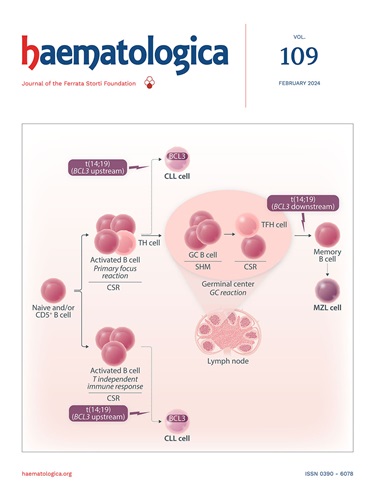Genetic risk classification in acute myeloid leukemia patients treated with hematopoietic cell transplantation and post-transplant cyclophosphamide.
IF 7.9
1区 医学
Q1 HEMATOLOGY
引用次数: 0
Abstract
We analyzed outcomes of 217 AML patients in complete remission who underwent allogeneic HCT with myeloablative conditioning and post-transplant cyclophosphamide-based GVHD prophylaxis, aiming to assess the prognostic significance of genetic risk categories. In the overall cohort, the 2-year overall survival (OS) and event-free survival (EFS) were 77% (95% CI, 71-83) and 72% (95% CI, 66- 78), respectively. ELN2022 risk stratification lacked prognostic value in HCT. Instead, we identified four risk categories with distinct impact on OS: standard risk (ELN2022 favorable/intermediate and adverse-risk without high-risk genetic under the defined subcategories), intermediate risk (≥2 myelodysplasia-related gene mutations) (HR 2.23, 95% CI 1.14-4.92), adverse risk (complex karyotype, monosomal karyotype, inv(3)/t(3;3), KMT2A rearrangement) (hazard ratio (HR) 4.24, 95% CI 2.00 - 9.02), and very adverse risk (TP53 mutations) (HR 6.81, 95% CI 3.00 - 15.5). These categories demonstrated similar predictive power for EFS and cumulative incidence of relapse. Moreover, integrating pre-transplant MRD refined risk stratification, identified MRDnegative patients with ≥2 myelodysplasia-related gene mutations whose OS and EFS were comparable to standard-risk patients. This refined classification improves the prognostic value of ELN2022 for AML patients undergoing allogeneic HCT with modern platform by integrating genetic features and MRD status to better guide post-transplant management.造血细胞移植和移植后环磷酰胺治疗急性髓系白血病患者的遗传风险分类。
我们分析了217例完全缓解的AML患者的结果,这些患者接受了同种异体HCT,并进行了清髓调节和移植后基于环磷酰胺的GVHD预防,旨在评估遗传风险类别的预后意义。在整个队列中,2年总生存率(OS)和无事件生存率(EFS)分别为77% (95% CI, 71-83)和72% (95% CI, 66- 78)。ELN2022风险分层在HCT中缺乏预后价值。相反,我们确定了四种对OS有明显影响的风险类别:标准风险(ELN2022有利/中等和不利风险,在定义的亚类别下没有高风险遗传),中等风险(≥2个骨髓增生异常相关基因突变)(HR 2.23, 95% CI 1.14-4.92),不良风险(复杂核型,单染色体核型,inv(3)/t(3;3), KMT2A重排)(风险比(HR) 4.24, 95% CI 2.00 - 9.02),以及非常不利风险(TP53突变)(HR 6.81, 95% CI 3.00 - 15.5)。这些分类对EFS和累积复发率的预测能力相似。此外,整合移植前MRD细化了风险分层,确定了MRD阴性且骨髓增生异常相关基因突变≥2个的患者,其OS和EFS与标准风险患者相当。这种精细化的分类通过整合遗传特征和MRD状态,通过现代平台提高了ELN2022对接受同种异体HCT的AML患者的预后价值,从而更好地指导移植后管理。
本文章由计算机程序翻译,如有差异,请以英文原文为准。
求助全文
约1分钟内获得全文
求助全文
来源期刊

Haematologica
医学-血液学
CiteScore
14.10
自引率
2.00%
发文量
349
审稿时长
3-6 weeks
期刊介绍:
Haematologica is a journal that publishes articles within the broad field of hematology. It reports on novel findings in basic, clinical, and translational research.
Scope:
The scope of the journal includes reporting novel research results that:
Have a significant impact on understanding normal hematology or the development of hematological diseases.
Are likely to bring important changes to the diagnosis or treatment of hematological diseases.
 求助内容:
求助内容: 应助结果提醒方式:
应助结果提醒方式:


